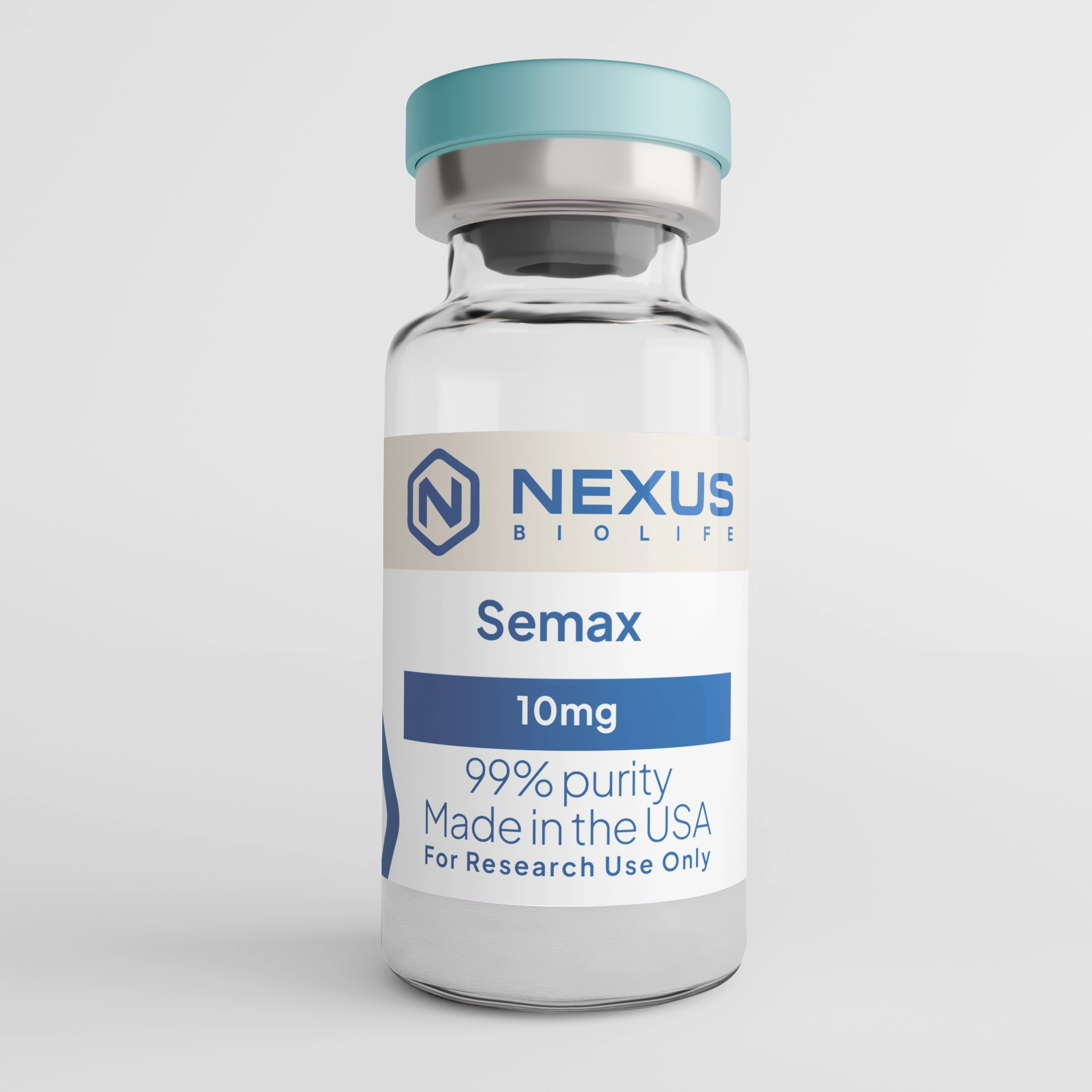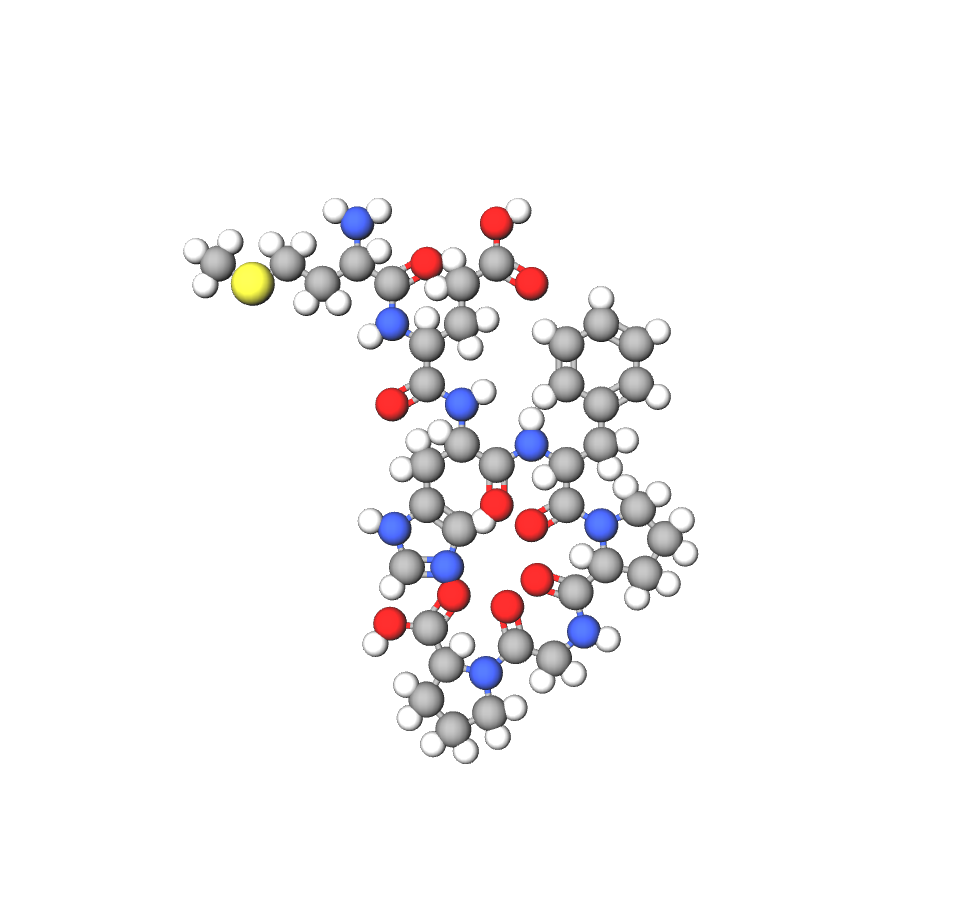
Semax is a synthetic peptide meticulously prepared for scientific inquiry. This product is synthesized with high purity. It is utilized in various laboratory investigations. Semax is designated solely for research and development purposes.

From a structural viewpoint, Semax comprises the amino acid chain Met-Glu-His-Phe-Pro-Gly-Pro (molecular formula C37H51N9O10S, molecular weight approximately 813.9 Da), featuring a free N-terminus and proline-rich C-end for resistance to enzymatic degradation. It exhibits high stability in aqueous solutions (half-life >24 hours in buffered media) and excellent bioavailability via intranasal routes in rodent models, crossing the blood-brain barrier efficiently due to its small size and lipophilicity. In lab preparations, it's supplied lyophilized for long-term storage at -20°C, readily soluble in sterile water or saline for reconstitution, and analyzed for purity exceeding 99% via HPLC and mass spectrometry. We approach these attributes methodically: structural insights refine dosing and delivery protocols, but our Semax is unequivocally for research purposes only.
At our company, we're all about making peptide science approachable and reliable for researchers like you. Semax is a synthetic heptapeptide analog of adrenocorticotropic hormone (ACTH) fragment 4-10, consisting of the sequence Met-Glu-His-Phe-Pro-Gly-Pro, designed to enhance neurotrophic and neuroprotective effects without the full hormonal activity of native ACTH. This water-soluble peptide, often administered nasally in research models for brain penetration, is primarily investigated for its role in modulating cognitive function and stress responses in cellular and animal assays. In research contexts, Semax is explored for potential neuroprotective properties, such as promoting neuronal survival under oxidative stress in vitro, always with strict adherence to laboratory use only—no indications for human consumption or therapeutic applications. Think of it as a focused instrument for probing brain plasticity, clear-cut and potent in experimental frameworks.
Delving into its origins, Semax was developed in the 1990s by Russian scientists at the Institute of Molecular Genetics, building on earlier ACTH fragment studies from the 1970s that identified the C-terminal region as key to behavioral modulation. Initial synthesis aimed to create a stable, non-glycosylated analog for central nervous system research, with early evaluations in rat models demonstrating improved learning and memory retention. Subsequent preclinical work expanded to ischemia and trauma simulations, revealing mechanisms like BDNF upregulation, which solidified its place in neuropharmacology investigations. We're appreciative of this lineage because it embodies deliberate, evidence-led innovation—steady progress that equips researchers with tools for targeted inquiries, unclouded by speculation.
To wrap things up, Semax represents the precision of peptide engineering tailored for neural research—a compact analog unlocking insights into cognition and protection. As your trustworthy guide in peptide science, we're pleased to supply such assets to propel your investigations, always with transparency and a welcoming hand extended. Whether exploring synaptic dynamics or stress adaptations, Semax provides a solid platform for discovery. Together, let's navigate the complexities of the mind with steady, informed steps.
Researchers often apply Semax in neurobiology studies, such as primary cortical neuron cultures to assess neuroprotection against glutamate excitotoxicity or in hippocampal slice assays for synaptic plasticity enhancements. It's also utilized in behavioral models, like maze tasks in mice to evaluate cognitive augmentation under stress, and in stroke simulations for infarct size reduction via anti-apoptotic pathways. We confirm our Semax's quality through comprehensive purity testing, ensuring dependable results in your experiments.
Practically, store the lyophilized form at -20°C protected from light, reconstituting to 0.1-1 mg/mL in sterile saline for intranasal or in-vitro applications. Typical research concentrations range from 10-100 µM in cell cultures or 50-500 µg/kg in animal models, adjusted per protocol—empirical validation is key. Importantly, Semax is designated solely for laboratory research, not for diagnostic, therapeutic, or human use. We're ready to assist with your protocols, emphasizing integrity and collaboration.
Scientifically, Semax has demonstrated neuroprotective and nootropic effects in experimental paradigms, such as elevating BDNF and NGF levels in rat brain tissues to support neurogenesis and counteract ischemia-induced damage. In vitro, it mitigates oxidative stress in astrocytes by activating antioxidant enzymes and modulating serotonin/dopamine balance, while animal studies show improved spatial memory and reduced anxiety-like behaviors without HPA axis disruption. Unlike full ACTH, it selectively targets melanocortin receptors for anti-inflammatory actions in microglial cultures, potentially aiding recovery in traumatic brain injury models through enhanced vascular permeability control. Our take? These mechanisms make Semax a precise tool for dissecting neuroresilience pathways, firmly rooted in rigorous, reproducible science.
At our company, we're all about making peptide science approachable and reliable for researchers like you. Semax is a synthetic heptapeptide analog of adrenocorticotropic hormone (ACTH) fragment 4-10, consisting of the sequence Met-Glu-His-Phe-Pro-Gly-Pro, designed to enhance neurotrophic and neuroprotective effects without the full hormonal activity of native ACTH. This water-soluble peptide, often administered nasally in research models for brain penetration, is primarily investigated for its role in modulating cognitive function and stress responses in cellular and animal assays. In research contexts, Semax is explored for potential neuroprotective properties, such as promoting neuronal survival under oxidative stress in vitro, always with strict adherence to laboratory use only—no indications for human consumption or therapeutic applications. Think of it as a focused instrument for probing brain plasticity, clear-cut and potent in experimental frameworks.
Delving into its origins, Semax was developed in the 1990s by Russian scientists at the Institute of Molecular Genetics, building on earlier ACTH fragment studies from the 1970s that identified the C-terminal region as key to behavioral modulation. Initial synthesis aimed to create a stable, non-glycosylated analog for central nervous system research, with early evaluations in rat models demonstrating improved learning and memory retention. Subsequent preclinical work expanded to ischemia and trauma simulations, revealing mechanisms like BDNF upregulation, which solidified its place in neuropharmacology investigations. We're appreciative of this lineage because it embodies deliberate, evidence-led innovation—steady progress that equips researchers with tools for targeted inquiries, unclouded by speculation.
To wrap things up, Semax represents the precision of peptide engineering tailored for neural research—a compact analog unlocking insights into cognition and protection. As your trustworthy guide in peptide science, we're pleased to supply such assets to propel your investigations, always with transparency and a welcoming hand extended. Whether exploring synaptic dynamics or stress adaptations, Semax provides a solid platform for discovery. Together, let's navigate the complexities of the mind with steady, informed steps.
From a structural viewpoint, Semax comprises the amino acid chain Met-Glu-His-Phe-Pro-Gly-Pro (molecular formula C37H51N9O10S, molecular weight approximately 813.9 Da), featuring a free N-terminus and proline-rich C-end for resistance to enzymatic degradation. It exhibits high stability in aqueous solutions (half-life >24 hours in buffered media) and excellent bioavailability via intranasal routes in rodent models, crossing the blood-brain barrier efficiently due to its small size and lipophilicity. In lab preparations, it's supplied lyophilized for long-term storage at -20°C, readily soluble in sterile water or saline for reconstitution, and analyzed for purity exceeding 99% via HPLC and mass spectrometry. We approach these attributes methodically: structural insights refine dosing and delivery protocols, but our Semax is unequivocally for research purposes only.

Researchers often apply Semax in neurobiology studies, such as primary cortical neuron cultures to assess neuroprotection against glutamate excitotoxicity or in hippocampal slice assays for synaptic plasticity enhancements. It's also utilized in behavioral models, like maze tasks in mice to evaluate cognitive augmentation under stress, and in stroke simulations for infarct size reduction via anti-apoptotic pathways. We confirm our Semax's quality through comprehensive purity testing, ensuring dependable results in your experiments.
Practically, store the lyophilized form at -20°C protected from light, reconstituting to 0.1-1 mg/mL in sterile saline for intranasal or in-vitro applications. Typical research concentrations range from 10-100 µM in cell cultures or 50-500 µg/kg in animal models, adjusted per protocol—empirical validation is key. Importantly, Semax is designated solely for laboratory research, not for diagnostic, therapeutic, or human use. We're ready to assist with your protocols, emphasizing integrity and collaboration.
Scientifically, Semax has demonstrated neuroprotective and nootropic effects in experimental paradigms, such as elevating BDNF and NGF levels in rat brain tissues to support neurogenesis and counteract ischemia-induced damage. In vitro, it mitigates oxidative stress in astrocytes by activating antioxidant enzymes and modulating serotonin/dopamine balance, while animal studies show improved spatial memory and reduced anxiety-like behaviors without HPA axis disruption. Unlike full ACTH, it selectively targets melanocortin receptors for anti-inflammatory actions in microglial cultures, potentially aiding recovery in traumatic brain injury models through enhanced vascular permeability control. Our take? These mechanisms make Semax a precise tool for dissecting neuroresilience pathways, firmly rooted in rigorous, reproducible science.
